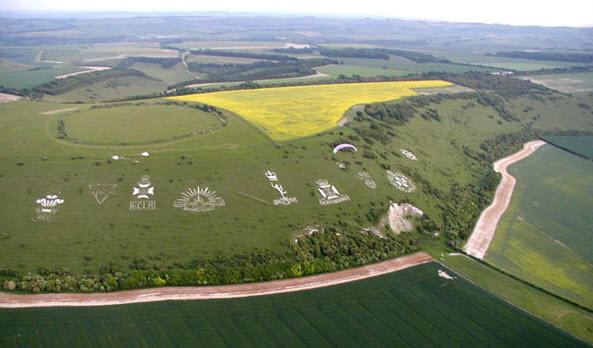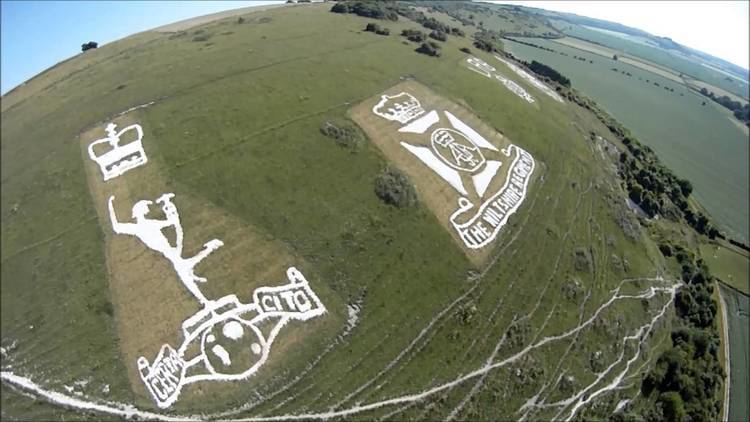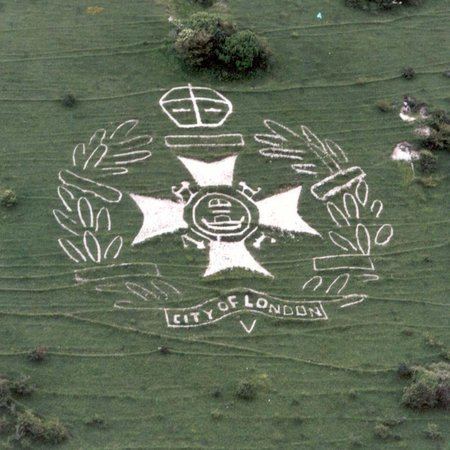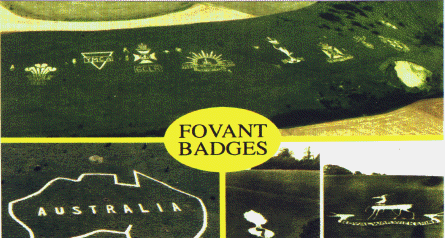 | ||
Fovant badges aerial view
The Fovant Badges are a set of regimental badges cut into a chalk hill, Fovant Down, near Fovant, in southwest Wiltshire, England. They are located between Salisbury and Shaftesbury on the A30 road in the Nadder valley; or some 1⁄2 mile (800 m) southwest of Fovant. They were created by soldiers garrisoned nearby, and waiting to go to France, during the First World War, the first in 1916, and are clearly visible from the A30 road which runs through the village. Eight of the original twenty remain, and are scheduled ancient monuments and recognised by the Imperial War Museum as war memorials. Further badges have been added more recently.
Contents
- Fovant badges aerial view
- Drone footage the fovant badges a set of regimental badges cut into a chalk hill
- Construction
- Current badges
- Centenary badge
- Lost badges
- Nearby badges
- Nearby
- References

The Fovant Badge Society holds an annual Drumhead Service which is attended by the Australian High Commissioner, local mayors and members of parliament. These services fund the upkeep of the badges.

Drone footage the fovant badges a set of regimental badges cut into a chalk hill
Construction

After the outlines were cut into the grass-covered hillsides, they were refilled with chalk brought from a nearby slope, up to 50 tons per badge. The badges took an average fifty men six months to complete.
Current badges
Reading left to right (north-east to south-west), the badges at Fovant are:

- Royal Wiltshire Yeomanry (only central part remaining)
- 6th (City of London) Battalion, London Regiment (City of London Rifles) (claimed to be the first of the badges cut here)
- Australian Commonwealth Military Forces (the largest, 51m×32m)
- Royal Corps of Signals (cut in 1970 to commemorate the Corps' 50th anniversary)
- Wiltshire Regiment (added in 1950)
- 5th (City of London Battalion, London Regiment (London Rifle Brigade)
- 8th (City of London) Battalion, London Regiment (Post Office Rifles)
- Devonshire Regiment
Centenary badge

To commemorate the centenary of the first badge, created in 1916, a badge in the shape of a poppy, to represent the poppies that grew in “Flanders Fields” has been created.
Lost badges

Except for the YMCA badge, which resided on the hillside for a long time, several of the other lost badges were short lived, small and crudely constructed.
- YMCA (in 2005, it was announced it is intended to allow this non-military badge to fade away. The figure faded away soon after and cannot be seen today)
- Royal Army Service Corps
- Royal Army Medical Corps, possibly on the site of where Royal Wiltshire Yeomanry is now.
- Machine Gun Corps
- Queen Victoria Rifles
- 35th Training Battalion
- 'Dingo'
- Post Office Rifles 'POR' letters, possibly there prior to the current Post Office Rifles figure.
- 7th Battalion of the City of London Regiment (there is also a figure for this Regiment in Sutton Mandeville)
- 9th Royal Berkshire Regiment
- 37th Training Battalion
- Voluntary Aid Detachment
Nearby badges
Two as-yet unrestored military badges at Sutton Down (Royal Warwickshire Regiment and the 7th Battalion, The London Regiment) and an outline map of Australia on Compton Down are also looked after by the Society. Along with YMCA's badge at Fovant, these three figures were allowed to grass over in 2005. The Australian map and 7th Battalion badge faded soon after, but the shape of the Royal Warwickshire Regiment badge could still be made out in the trees around it as of 2008.
On Lamb Down, to the side of the A36 within only miles distance of Fovant, is a cutting of the Australian Commonwealth Military Force badge, it is less detailed than the one at Fovant. It was cut in 1916–1917.
Additionally, near Barford St Martin, at the eastern end of the Fovant Encampment, was the Finsbury Rifles Badge. Not much is known about this figure.
Also about 20 miles distance of the Fovant Badges is another military hill figure, though not of a badge: the Bulford Kiwi, which resides in the grounds of the Bulford Camp. Ground views of the Bulford Kiwi can be seen from Tidworth Road, although the kiwi is obscured from this road. The kiwi can be seen from several miles back, in the opposite direction, however, but again obscured.
Nearby
Fovant Down is also the site of Chiselbury Iron age hillfort. This makes Fovant Down one of several downs in Wiltshire to contain both a hill fort and a hill figure (another example is Bratton Downs, home to both the Bratton Castle hill fort and the Westbury White Horse directly beneath it)
